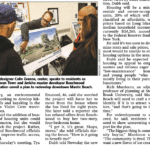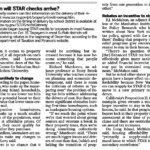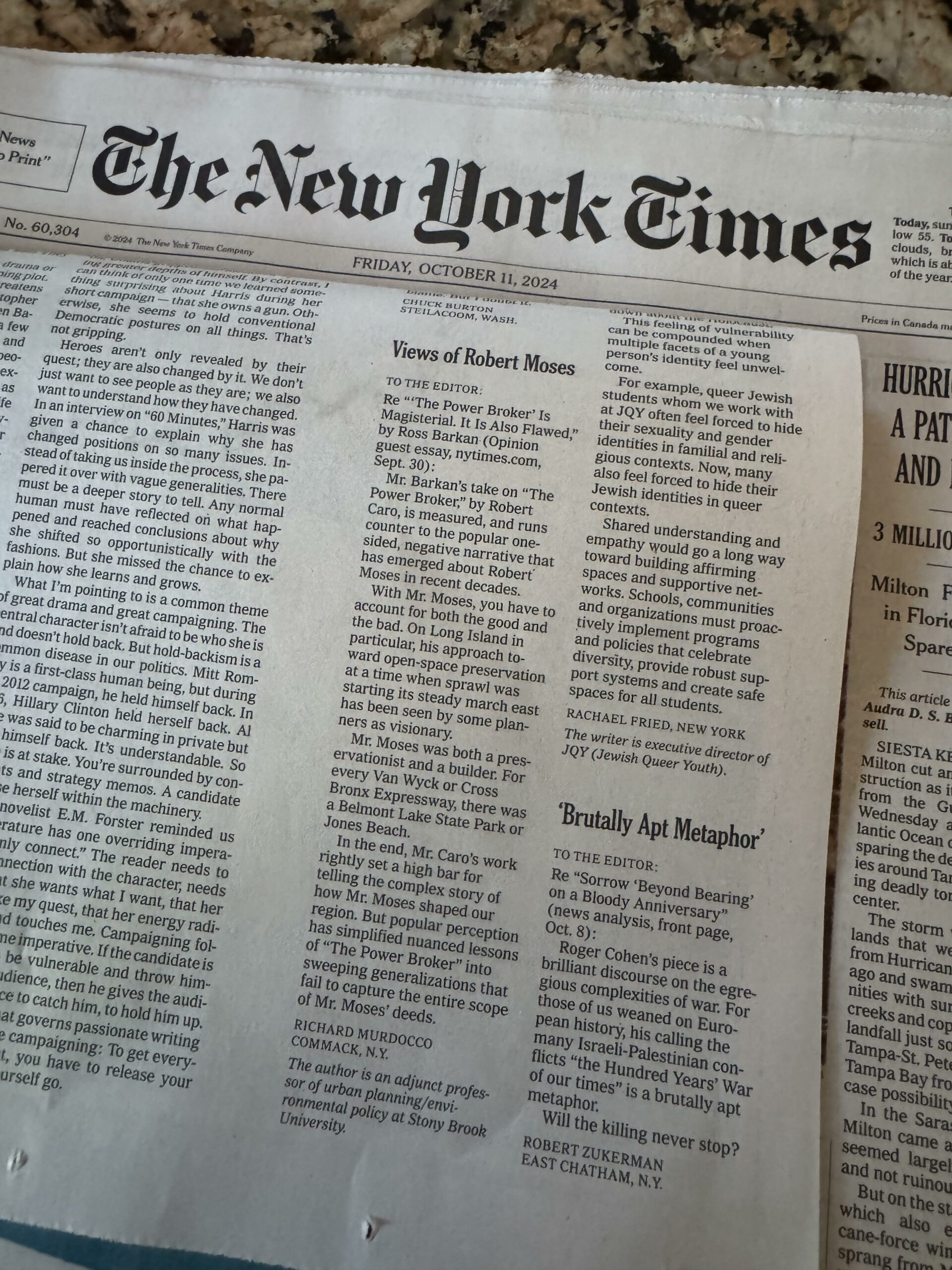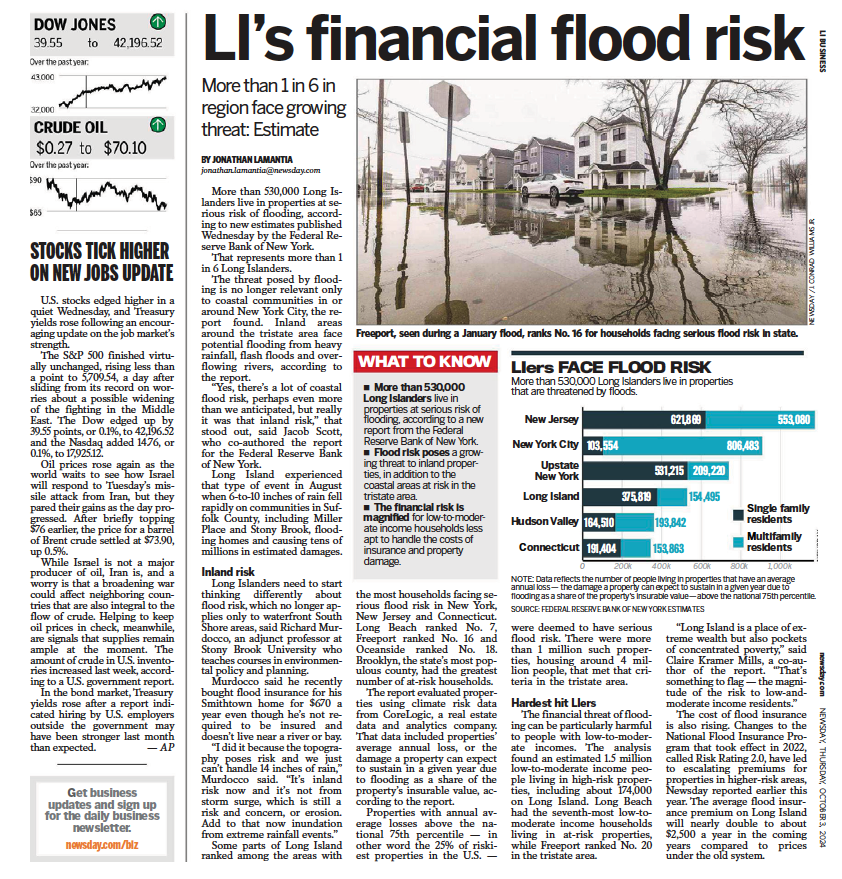The following was originally published in The Real Deal’s Long Island Market edition in March 2017. You can read the original version here.
Cuomo finds funds to update Long Island’s transit and utilities.
With news of New York Gov. Andrew Cuomo’s plan to provide state funds to improve the Long Island Rail Road and expand Long Island’s sewer systems, as well as the Long Island Power Authority’s recent agreement with Deepwater Wind to build a wind farm off Montauk, big investments in infrastructure appear to be headed to the Island.
“With these projects, we equip Long Island with the tools and resources to drive commercial activity, create jobs and build a stronger Long Island for generations to come,” Cuomo said during a State of the State address in January.
Local real estate experts are optimistic about what that means for the industry.
“Improving Long Island’s infrastructure will foster the growth of our economy and allow for the development of vibrant transit-oriented walkable communities,” Bob Coughlan, a principal at Setauket-based Tritec, told TRD.
Hearings on Cuomo’s budget proposal are planned in the next month or so, with a vote expected before April. The wind farm has cleared some hurdles recently, but is not a done deal yet.
Following is a look at the details of the infrastructure improvements in the works.
A third track
The governor is pushing the LIRR to build a third track between the Village of Floral Park and Hicksville, one of the largest commuter hubs on Long Island. The project is estimated to cost between $1 billion and $1.5 billion, according to the Metropolitan Transportation Authority, and has been the subject of multiple public hearings.
The 9.8-mile stretch of rail is one of the most heavily trafficked in the country, and advocates — including the Long Island Association, trade unions and many commuters — say the project is critical in order to enhance the LIRR’s resiliency and the ability to support reverse commuters from New York City. Not everyone is happy, however.

I think delays are a problem, but it’s not the third track, or lack thereof, it’s broken rails. It’s defective signals, and so on and so forth,” New Hyde Park Mayor Robert Lofaro told Newsday in January. “We do not believe a third track is necessary and will solve all the problems.” The Village of Floral Park is strongly opposing the project as well.
The LIRR is actively working on adding a second track between Farmingdale and Ronkonkoma, effectively doubling the busy commuter corridor’s capacity. The $288 million project has been under construction since 2014 and is projected to be completed in 2018, complete with a new LIRR station at Republic Airport in East Farmingdale.
New LIRR stations
Cuomo is also pushing for a total investment of $120 million that would provide substantive “enhancements” to 16 stations — almost all major commuter hubs — throughout the rail system.
“Enhanced LIRR stations will connect further than they ever have before,” Cuomo said in January. The stations that would benefit in Nassau County are Baldwin, Bellmore, Farmingdale, Great Neck, Merrick, Stewart Manor, Syosset and Valley Stream; in Suffolk County, Brentwood, Deer Park, East Hampton, Northport, Ronkonkoma, Stony Brook, Port Jefferson and Wyandanch would be affected.
Station upgrades would include rehabbed platforms, public art, Wi-Fi and charging stations, as well as improved signage. Of the total $120 million, $80 million would be distributed evenly between the 16 stations. The remaining $40 million would go toward adding a stop at the Brookhaven National Laboratory in Upton, as well as supporting the development of a new terminal at MacArthur Airport, located 60 miles east of Manhattan, to allow for a direct link to the LIRR.
At Brookhaven National Lab, the proposed LIRR station complements the lab’s plans to construct Discovery Park, a 730,000-square-foot, 40-acre project that would provide housing for the lab’s scientists, as well as create a new public-facing gateway to the lab. The new station would also serve a new 850-unit mixed-use, privately built development located across from the lab’s campus in Yaphank.
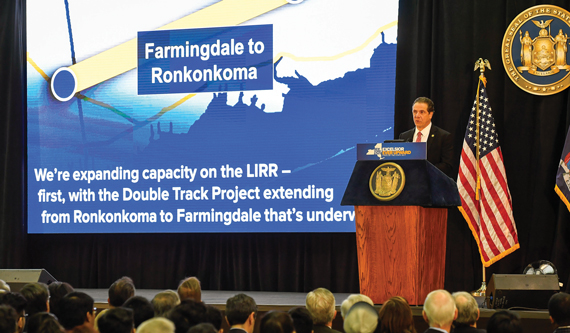
Gov. Andrew Cuomo announced his infrastructure improvement plans at a State of the State address in January.
In Islip, the newly relocated MacArthur Airport terminal, long advocated by the region’s planning community, would give Long Islanders a direct connection to the LIRR as well as to the 1,450-unit, $700 million Ronkonkoma Hub.
Wastewater
Sewers on Long Island, particularly in Suffolk County, are a big deal — mainly because most of the county doesn’t have them. So locals welcomed the news of Cuomo’s $2 billion commitment to protect water throughout New York State.
“There is no place in the state that will benefit more than Long Island from this funding,” State Assembly member Fred Thiele, who represents most of the Island’s East End, said in a statement. Due to the region’s lack of wastewater treatment, many areas have had their allowable buildable densities reduced by zoning in order to lessen the impact of development on the region’s drinking water.
The governor is proposing a $40 million sewering project in both Smithtown and Kings Park, two downtown areas located on the North Shore in Suffolk County that have long been identified by planners and builders as suitable candidates for sewers. The proposal calls for $20 million to add sewers in Smithtown’s downtown business district and using the remaining funds to construct a new wastewater plant in Kings Park.
“It will allow more business to come into the area,” said Jim Haydon, a salesperson with Signature Premier in Smithtown.
Wind energy
The Long Island Power Authority reached a deal in January for a wind farm in the Atlantic Ocean, located within a 256-square-mile parcel about 35 miles from Montauk Point. Deepwater Wind will develop the $740 million, 200-turbine project, and officials say it could start producing energy by the end of 2022.
Deepwater Wind’s project may be the first of three wind farms slated for the waters south of Long Island, but it has several hurdles to clear. Opponents of the project include commercial fishermen, who worry about the long-term impact on the New York Bight, some of the most productive fishing waters on the eastern seaboard.
For those worried about the view, experts say not to worry. “Since the contract is approved for a project that will be 30 miles from Montauk, it will be impossible to see from anywhere on Long Island,” said Neal Lewis, executive director of the Sustainability Institute at Molloy College.





